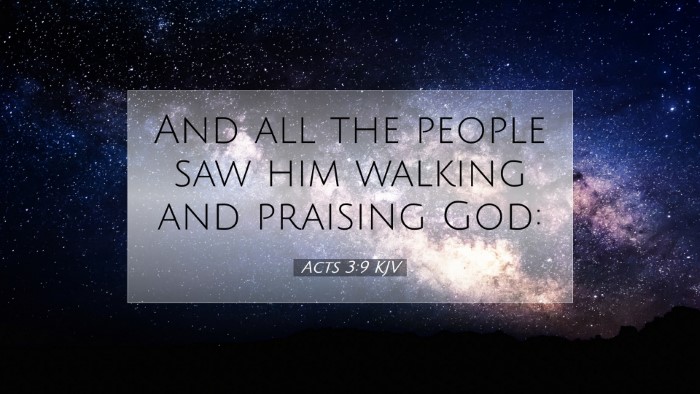Old Testament
Genesis Exodus Leviticus Numbers Deuteronomy Joshua Judges Ruth 1 Samuel 2 Samuel 1 Kings 2 Kings 1 Chronicles 2 Chronicles Ezra Nehemiah Esther Job Psalms Proverbs Ecclesiastes Song of Solomon Isaiah Jeremiah Lamentations Ezekiel Daniel Hosea Joel Amos Obadiah Jonah Micah Nahum Habakkuk Zephaniah Haggai Zechariah MalachiActs 3:9
Acts 3:9 KJV
And all the people saw him walking and praising God:
Acts 3:9 Bible Commentary
Commentary on Acts 3:9
Bible Verse: "And all the people saw him walking and praising God."
Introduction
The verse Acts 3:9 is situated in a pivotal narrative in the early church, where the healing of a lame man by the apostles Peter and John serves as a significant event that propels the message of Christ forward. This commentary draws insights from various public domain sources, including Matthew Henry, Albert Barnes, and Adam Clarke, to provide a diverse yet unified understanding of the verse.
Contextual Background
The miracle described in Acts 3 occurs shortly after the ascension of Jesus and the day of Pentecost, where the Holy Spirit filled the disciples. The healing of the lame man at the Beautiful Gate not only demonstrates the power of God manifesting through the apostles but also serves as a prelude to the apostolic preaching that would follow.
Historical Significance
Matthew Henry emphasizes the importance of this miracle in establishing the credibility of the apostles as they begin their ministry. The healing acts as both a sign and a wonder, drawing the attention of the bystanders to the message that they were preaching, which was centered on Christ.
The Reaction of the People
As the verse indicates, "all the people saw him walking and praising God," the public reaction is integral to understanding the impact of this miracle. Albert Barnes notes that the visible transformation in the man who was once incapacitated highlights the transformative power of faith and the divine intervention at work. The healed man’s act of praising God serves as a public testimony of God’s goodness, further inviting others to consider the claims of the gospel.
Theological Implications
This verse speaks volumes about the nature of faith and the work of God in the lives of believers and non-believers alike. The miracle is not just a physical healing; it is a demonstration of God’s power, showcasing His ability to redeem and restore. Adam Clarke suggests that the phrase "walking and praising God" encapsulates the totality of human response to divine grace—movement towards God accompanied by adoration and worship.
Faith in Action
One notable aspect of this verse, as highlighted in various commentaries, is that faith manifests in action. The healed man’s walking indicates that faith has tangible effects. Matthew Henry provides insight that true faith is never passive but is always transformative. The act of engaging in public praise also emphasizes the communal aspect of faith—how the work of God in an individual’s life can lead to communal worship and acknowledgment of God's greatness.
The Role of Witnessing
The public nature of this miracle fosters a witness to the power of God among the people. Albert Barnes points out that witnessing God's power at work is a fundamental aspect of the Christian experience. It encourages believers to openly declare what God has done in their lives, thereby amplifying the message of the gospel. This serves to instruct pastors and theologians on the importance of fostering environments where such testimonies can be shared and celebrated.
Application for Today's Believers
The implications of Acts 3:9 extend well into the modern church and serve as a model for the engagement of believers within their communities. The visible change in the healed man is a call to all Christians to embody the change that faith in Jesus brings.
Encouragement for Pastors
- Inspiring Faith: Pastors are encouraged to inspire their congregations by sharing testimonies of God’s transformative work, similar to the way the healed man's praise inspired those around him.
- Community Impact: The narrative encourages church leaders to engage their communities, demonstrating the love and power of God through acts of service and testimony.
Guidance for Students and Theologians
- Study of Miracles: Students and scholars are invited to delve into the nature of miracles within the New Testament, considering how they serve to authenticate the message of Christ.
- Theological Reflections: Reflection on the theological implications of divine intervention in the lives of individuals and communities is essential for a deeper understanding of God's ongoing work.
Conclusion
Acts 3:9 serves as a profound reminder of the hope and restoration available through Jesus Christ. In bringing this verse into our contemporary context, we are reminded of our calling to be vessels of God’s grace, sharing the stories of His goodness and encouraging others to join in the chorus of praise. As believers witness God’s transformative work in their lives, it becomes imperative to share that experience to attract others to the faith, thereby fulfilling the Great Commission in our generation.


